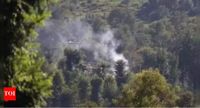A shopkeeper was killed and a gurdwara was damaged as Pakistan launched heavy shelling early Wednesday in the Poonch district of Jammu and Kashmir. Eyewitnesses described the intensity of the bombardment as worse than during the 1999 Kargil War.
According to officials, Amreek Singh, the local shopkeeper, was killed instantly when a shell exploded outside his shop near Syndicate Chowk as he arrived to open it, sending shockwaves through the community. A nearby gurdwara, located just a short walk from Singh’s shop, was also struck during the shelling, and its wall sustained considerable structural damage. Fortunately, no one was reported injured inside the gurdwara.
After the Pakistani shelling, many families in Poonch began fleeing toward Jammu, seeking safety amid fears of further violence. At least seven other civilians were killed and 38 injured in Jammu and Kashmir, following strikes by India on terror targets in Pakistan and Pakistan-occupied Kashmir under Operation Sindoor. Officials reported that one person was killed in Mendhar, and six died in Poonch.
“During the night of 06-07 May 2025, Pakistan Army resorted to arbitrary firing, including artillery shelling from posts across the Line of Control and IB opposite J&K,” said Lt Colonel Suneel Baratwal, PRO (Defence), Northern Command. A woman was reported killed in Mankote, though officials have yet to confirm her death.
In a broader context, the violence was part of a significant escalation in hostilities between India and Pakistan. On the same day, it was reported that seven persons, including a woman and two children, were killed and 38 others injured as the Pakistan Army shelled forward villages along the Line of Control (LoC) in Jammu and Kashmir. The Indian Army is responding proportionately to ceasefire violations by Pakistani forces, which began after India conducted missile strikes on nine terror targets in Pakistan and Pakistan-occupied Kashmir.
The Poonch district has been the worst affected, with seven fatalities and 25 others injured, according to reports. In addition, ten people were injured in the Uri sector of Baramulla district, while three others sustained injuries in Rajouri district.
In the early hours of Wednesday, India launched "Operation Sindoor," executing a series of precision strikes that successfully destroyed nine terrorist bases located in Pakistan and Pakistan-occupied Kashmir (PoK). The operation was a joint effort by the Army, Navy, and Air Force, and was conducted entirely from Indian soil. Key targets included the Jaish-e-Mohammed (JeM) headquarters in Bahawalpur and Lashkar-e-Taiba’s (LeT) base in Muridke.
The strikes served as a decisive response to the April 22 terrorist attack in Pahalgam, which had claimed the lives of 26 civilians. Using advanced precision weaponry and real-time intelligence, the Army, Navy, and Air Force conducted the strikes in coordination, avoiding any engagement with Pakistani military installations. India employed a range of high-precision, long-range strike weapons during the operation, including the SCALP cruise missile, the HAMMER precision-guided bomb, and loitering munitions.
Pakistan's response to India's Operation Sindoor was immediate and aggressive. Reports indicated that Pakistan has been trying to target assets of the United Nations in Jammu and Kashmir after Indian forces struck terror camps in Pakistan and Pakistan-occupied Kashmir. An artillery shell fired by the Pakistan Army narrowly missed a UN field station and fell outside its gate in Poonch, about 160 km from Srinagar.
Earlier in the day, UN Secretary-General Antonio Guterres expressed concern over the flare-up in India-Pakistan tensions, stating that the world "cannot afford a confrontation" between the two countries. "The Secretary-General is very concerned about the Indian military operations across the Line of Control and international border. He calls for maximum military restraint from both countries," said Stephane Dujarric, the UN chief's spokesperson.
As the situation escalates, the Indian Army confirmed that it is responding appropriately to the ceasefire violations by Pakistani forces. On May 7, 2025, Pakistani troops violated the ceasefire agreement along the LoC by resorting to intense shelling towards the Indian side. The Indian Army is responding to Pakistani shelling in equal measure.
In the aftermath of these events, the local community in Poonch is left reeling from the violence. The death of Amreek Singh has cast a pall over the area, with many residents expressing fear and uncertainty about the future. The ongoing conflict has not only led to loss of life but has also displaced families and created a climate of fear.
As the international community watches closely, the potential for further escalation remains a significant concern. The Indian government has reiterated its commitment to defending its territory and responding to acts of aggression, while Pakistan continues to assert its stance in the ongoing conflict.
In summary, the events of May 7, 2025, mark a troubling chapter in the long-standing conflict between India and Pakistan, with civilian casualties and international implications highlighting the urgent need for dialogue and resolution.





